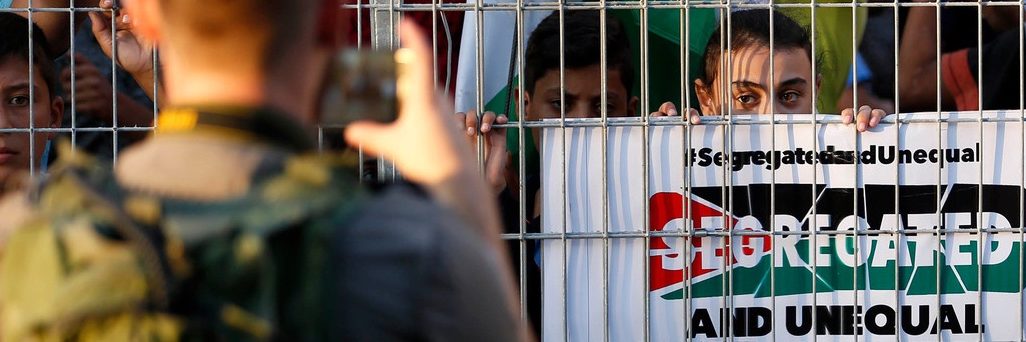Using Maps to Analyze U.S. Middle East Policy
Maps 1 & 2: Pre Israel Land Ownership and Population Distribution
Background:
The purpose of this exercise is to share with students the United States's role in the Israeli/Palestinian issue as exemplified by positions the United States took in 1947 as part of the UN Partition Plan and in 2020 as part of the "Deal of the Century."
The United States became significantly involved in the Palestine issue in 1947 (before the creation of the state of Israel). During that year the US lobbied hard to divide Palestine into a Jewish and an Arab state. The US threatened to cut off aid to countries that did not vote to partition Palestine at the UN. This was shortly after World War II and the Holocaust, a time when many countries needed aid to repair their countries battered by the war.
The first two maps represent land ownership and population in what was Palestine in 1945-6. These two maps provide students with an understanding of the demographic situation when the US promoted the 1947 Partition Plan. The exercise is to look at each map in the order presented and answer the respective questions related to each map.
Map 1: Land Ownership 1945
(To see map 1 click on this link: https://www.un.org/unispal/document/auto-insert-196499/)
- Which sub-districts are predominantly owned by Arabs; which sub-districts are predominantly owned by Jews?
- If you were going to divide the land into a Jewish state and an Arab state, how would you do it based on land ownership?
Map 2: Population 1946
(http://www.passia.org/media/filer_public/bc/e1/bce1a0c8-06cc-4cd4-a94a-7d8704cb74d1/pdfresizercom-pdf-crop_11-page-001.jpg)
- Which sub-districts are populated predominantly by Jews; which sub-districts are populated predominantly by Arabs?
- If you were going to divide the land into a Jewish state and an Arab state, how would you do it based on population?
Map 3: UN Palestine Partition Plan
(https://commons.wikimedia.org/wiki/File:UN_Palestine_Partition_Versions_1947.jpg)
Note: 56% of the land was proposed to be part of the Jewish state and 43% was proposed to be part of the Arab state. Approximately 1/3 of the population was Jewish and 2/3 of the population was Arab. The remaining land, including Jerusalem and Bethlehem, was in neither state; it was part of an international zone.
- Do you see how the map somewhat relates to land ownership and population percentages?
- Where does the land allocation most deviate from land ownership and/or population?
- How defensible (militarily) or practical (trade, freedom of movement, etc) do you think either of these two states are? Why or why not?
- Note the city of Jaffa on the Mediterranean. Why do you think it was made to be part of the Arab state even though it is completely surrounded by the Jewish state? (Hint: look at the prior maps of population and land ownership).
- Imagine you were shown this map in 1947. How would you feel if you were Jewish? How would you feel if you were Arab? Which groups do you think would accept this map and which would reject it? Why?
Map 4: United States 2020 “Deal of the Century” – Peace to Prosperity
(See Map of Palestine on p. 46 /181 of the PDF document found at: https://trumpwhitehouse.archives.gov/wp-content/uploads/2020/01/Peace-to-Prosperity-0120.pdf)
On January 28, 2020 the United States unveiled what was called the “Deal of the Century.” The official document entitled: “Peace to Prosperity - A Vision to Improve the Lives of the Palestinian and Israeli People” (https://trumpwhitehouse.archives.gov/peacetoprosperity/). It included maps of Israel and “A Future State of Palestine.” Both maps had the following note: “Implementation of the Conceptual Map is subject to the terms and conditions provided in the Vision for Peace.” This Vision for Peace document has many symmetrical aspects (the same conditions applied to Israel and Palestine) but also some asymmetries. Examples of the asymmetries include:
- “A realistic solution would give the Palestinians all the power to govern themselves but not the powers to threaten Israel. This necessarily entails the limitations of certain sovereign powers in the Palestinian areas (henceforth referred to as the “Palestinian State”) such as maintenance of Israeli security responsibility and Israeli control of the airspace west of the Jordan River.”
- Palestine would have no control of any of Israel’s airspace and no part of Israel would be under Palestinian security control; Israel would have the powers not only to “threaten” Palestine but would in perpetuity be the military power over Palestine.
- “The state of Palestine shall be fully demilitarized and remain so.”
- Israel is not required to demilitarize any part of Israel – to the contrary, as mentioned above, the US Vision for Peace requires the Israeli military maintain security of Palestine.
- “The United States does not expect the State of Israel to negotiate with any Palestinian government that includes any members of Hamas, PIJ or surrogates thereof, unless that Palestinian government (including its members from Hamas or PIJ) unambiguously and explicitly commit to nonviolence, recognize the State of Israel, and fully satisfy the other Gaza Criteria, set forth in Section 9.”
- No similar limitations of members of the Israeli government or commitments to nonviolence are placed on Israel. There is no limitation for example of Israeli parties which insist on Jewish supremacy – in Israel or from the Jordan to the Mediterranean – or parties which oppose equality for all Israel’s citizens.
- “All persons and goods will cross the borders into the State of Palestine through regulated border crossings, which will be monitored by the State of Israel...Two access roads will be built for the benefit of the State of Palestine that will be subject to Israeli security requirements. These roads will enable Palestinians to cross the Jordan Valley to the border crossing with the Hashemite Kingdom of Jordan.”
- The Vision for Peace has no Israeli roads, including none that involve the border crossings with other countries, or the access roads to Israeli enclaves completely surrounded by Palestine, subject to Palestinian security requirements.
- “The Israeli-Palestinian Peace Agreement shall provide for a complete end and release of any and all claims relating to refugee or immigration status. There shall be no right of return by, or absorption of, any Palestinian refugee into the State of Israel.”
- Even though Palestinian refugees will not be allowed to return to their lands in Israel, the Vision for Peace requires Palestine have “A commitment to upholding property rights” potentially forcing Palestinians to give up land that was owned by Jews prior to 1948.
- “The rights of Palestinian refugees to immigrate to the State of Palestine shall be limited in accordance with agreed security arrangements.”
- The Vision for Peace includes no denial of the international Right of Return to Jews nor does it limit Israel’s immigration or who may become a citizen of, or live in, Israel.
- In looking at the US proposed map and the Vision for Peace that was part of the proposal, how do you think Jewish Israelis would feel about this state? How do you believe Palestinians in the West Bank and Gaza would feel about this state? How do you think Israeli Arabs who would no longer live in Israel, because their communities would now be considered part of this new Palestinian, state would feel?
- What are the practical aspects of this map? What are the potential problems with this map?
- Does the US proposal provide sovereignty to the state of Palestine? Does it provide self-determination for Palestinians?
- The map is based on the Vision of Peace document. What difference is there between the current Israeli occupation of the occupied Palestinian territories and the proposed state of Palestine? For example, does the structure of the US proposal create a difference in:
- restrictions to Palestinians on their freedom of movement within the territory and to and from other countries,
- restrictions as to who is given or denied permission by Israel to live in the territory,
- restrictions on trade with other countries,
- access to the lands Palestinians own in the West Bank which will become part of the proposed Israel,
- Palestinian safety from Israeli settlers and the Israeli military from whom they have endured violations of human rights and attacks without protection for decades, or
- daily life, including for example checkpoints, limitations on access to goods, and the same level of phone service as Israelis?
If you were to propose a “Vision for Peace,” what would it look like? Would it be like the 2020 US Vision for Peace? If not, how would it be different?
In Summary:
- What do these maps tell us about the role of the US in working for peace in Israel/Palestine?
- How does the US position over the years reflect American values? Does the US appear as an honest broker or impartial mediator?
- How does the US treat the situation (self-determination, occupation, human rights, etc) similarly or differently from others in the world?
Resources:
- These maps:
- Map 1: Land Ownership of Palestine, 1945: https://www.un.org/unispal/document/auto-insert-196499/
- Map 2: Population of Palestine by Sub-District, 1946: http://www.passia.org/media/filer_public/bc/e1/bce1a0c8-06cc-4cd4-a94a-7d8704cb74d1/pdfresizercom-pdf-crop_11-page-001.jpg
- Map 3: UN General Assembly Resolution 181 (II) Partition Plan: https://commons.wikimedia.org/wiki/File:https://commons.wikimedia.org/wiki/File:UN_Palestine_Partition_Versions_1947.jpg. Also used in https://blogs.timesofisrael.com/how-does-trumps-partition-plan-compare/.
- Map 4: Peace to Prosperity – A Vision to Improve the Lives of the Palestinian and Israeli People. Vision for Peace document including map in Appendix 1 – Conceptual Maps, p. 46 of https://trumpwhitehouse.archives.gov/wp-content/uploads/2020/01/Peace-to-Prosperity-0120.pdf
- Other related maps:
- Palestine: Index to Villages and Settlements (With Jewish land ownership): https://www.loc.gov/resource/g7501f.ct000173/?st=image&r=-0.35,0.157,1.113,0.649,0
- OCHA Map of West Bank – West Bank Access and Restrictions July 2018: https://www.ochaopt.org/atlas2019/images/db/wb-closure/6.jpg

